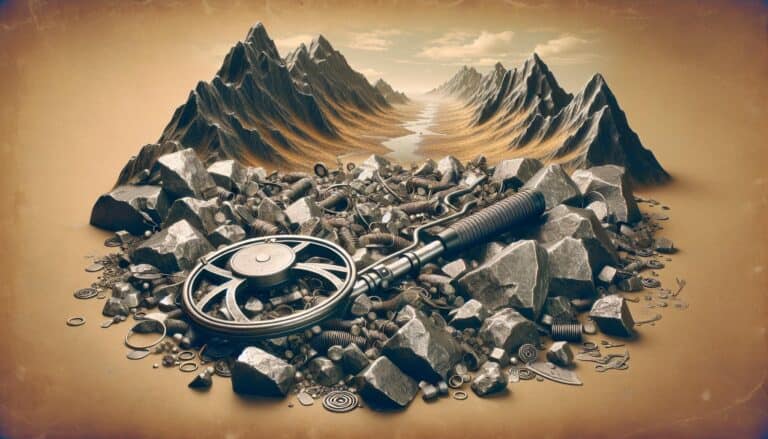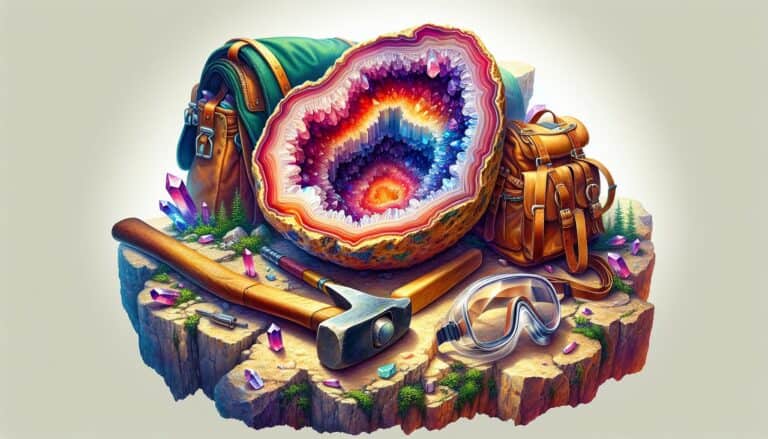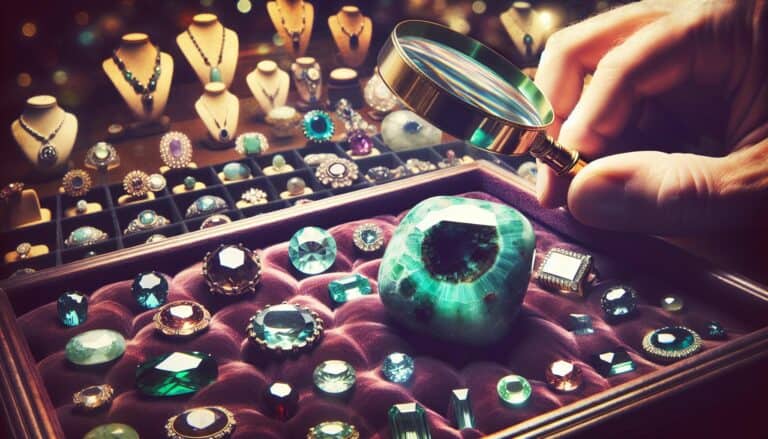Ever stumbled upon a shiny mineral and wondered if it’s the sought-after sphalerite?
This gemstone, also known as zinc blende, is not only a valuable ore of zinc but also a collector’s delight.
Identifying sphalerite can be a bit tricky, but with the right know-how, you’ll be spotting it like a pro in no time.
To identify sphalerite, check for its resinous luster and color range from yellow to dark brown. Conduct a white streak test, verify non-magnetism, and assess hardness (3.5-4 on Mohs scale). Sphalerite exhibits low birefringence, is transparent to translucent, has double refraction, and a specific gravity of 3.9-4.1.
How to Identify sphalerite Through Testing
When determining whether you’ve found sphalerite, consider various tests to confirm your findings. Each test gives you more insight into the properties of the mineral you’re examining. Remember, while some tests can be done on the spot, others may require specialized equipment.
Visual Inspection
Start with a thorough visual inspection. Sphalerite typically presents a resinous to adamantine luster and a range of colors—from pale yellow to dark brown or red. Note any visible cleavage planes, as sphalerite often exhibits perfect cleavage in six directions.
The Streak Test
Conduct a streak test by scratching your specimen across an unglazed porcelain tile. Sphalerite will leave a streak that’s white to light brown. This simple test can be pivotal in differentiating it from similar minerals.
Magnet Test
Sphalerite is generally non-magnetic. By using a strong magnet, you can test for magnetism. If your sample is attracted to the magnet, it’s likely not sphalerite.
Hardness Test
Utilize the Mohs scale to determine the mineral’s hardness. Sphalerite falls between 3.5 and 4, which means it’s soft enough to be scratched by a steel knife but too hard to be scratched by a fingernail.
Birefringence Test
Observe the mineral under a polarizing microscope to check for birefringence. If you notice a play of colors as you rotate the sample, this optical property is an indicator of sphalerite.
Checking The Diaphaneity
Inspect how light passes through the sphalerite. It can be transparent to translucent. If your sample allows light to pass through but not clearly, it indicates translucency — a common feature of sphalerite.
Single or Double Refraction
Sphalerite exhibits double refraction. When looking through the mineral, observe if images appear doubled. If so, this can be a telltale sign of sphalerite.
Refractive Index Test
A refractometer can measure the refractive index of sphalerite, typically ranging from 2.37 to 2.42. Values outside this range suggest you may be dealing with a different mineral.
Finding The Specific Gravity
Sphalerite has a high specific gravity, around 3.9 to 4.1. You can calculate this by measuring the weight of the mineral in air compared to its weight in water. Higher values are suggestive of sphalerite’s dense composition.
Identifying Sphalerites in the Field
When you’re in the field, look for sphalerite in its common environments such as limestones, pegmatites, and high-temperature ore veins. Its association with other minerals like galena and pyrite can also be a clue to its presence.
Recognizing Potential Sphalerite Rocks
Finally, familiarize yourself with the typical host rocks for sphalerite. It’s frequently found within dolostones and limestones. Be vigilant for rocks that exhibit potential veins or pockets where sphalerite crystals may have formed. Keep your eyes peeled for its distinctive luster and cleavage, which can jump out even to the untrained eye.
As you conduct these tests and observations, you’ll gain a better understanding of whether you’ve indeed found sphalerite or if you need to keep searching. These identify methods offer a comprehensive approach to confirming your mineral findings without heading to a laboratory.
Physical Characteristics of sphalerites

Sphalerite, a critical mineral, boasts unique physical traits that can aid in its identification. Initially, you’ll notice its lustrous and resinous appearance, which can range from transparent to translucent. This distinctive luster makes sphalerite easy to pick out when you’re examining rock samples.
The color spectrum of sphalerite is diverse. Typically, you’ll find it in shades of brown, yellow, red, green, and black. Less commonly, it can appear in clear or light shades, but this is rare and usually found in pure samples.
Crystalline structure is another indicator. Sphalerite forms in tetrahedral or dodecahedral crystals. However, when you’re out in the field, it’s also common to see it as massive and granular aggregates, which can be equally informative.
Texture-wise, sphalerite is brittle. If you’re trying to identify a sample, a piece that breaks off might reveal a perfect cleavage that is characteristic of the mineral, displaying its internal cleavage pattern in three directions.
Keep in mind, the mineral’s streak is usually pale yellow to brown, which means a streak test on unglazed porcelain should yield clearent results. Paying attention to these physical characteristics when examining potential sphalerite specimens will significantly enhance your identification process.
How Are sphalerite Formed?
Sphalerite, a mineral that’s integral to the world’s supply of zinc, originates through a fascinating geological process. Hydrothermal activity is the primary driver in the formation of sphalerite. This occurs when superheated water, rich in various minerals, flows through crevices deep within the Earth’s crust. Over time, the chemical reactions between the hot fluids and surrounding rocks result in the crystallization of minerals, including sphalerite.
During the formation process, sphalerite crystals grow in environments with high concentrations of sulfides. The temperature and pressure conditions of these subsurface locations are critical in determining the mineral qualities of sphalerite. Interestingly, sphalerite can form massive, bedded, or vein deposits, each with distinct appearances and textures that aid in its identification.
The mineral’s journey doesn’t end underground. Weathering and erosion can expose sphalerite to the surface, leading to secondary changes in its structure and appearance. When inspecting potential sphalerite samples, you’re often observing the end result of millions of years of geological activity.
Remember, your investigation of sphalerite’s origin can provide insights into the environmental conditions it endured. Such details enhance your ability to recognize and differentiate sphalerite from other similar minerals.
Preparation for sphalerite Hunting
Before embarking on your sphalerite hunting adventure, there are essential steps you must take to ensure a productive and safe experience. Preparing effectively means gathering the right tools and considering safety measures that’ll keep you secure during your search.
Gathering the Right Tools
The process of identifying sphalerite in the field requires specific tools tailored to mineralogy. Here’s a list of must-have items for your expedition:
- Geologist’s hammer: A fundamental tool used to extract samples.
- Hand lens: Magnifies small details for closer inspection of potential sphalerite.
- Chisel and gloves: Protect your hands and assist in prying samples from host rocks.
- Field guide: Serves as a visual reference to compare physical characteristics.
- GPS device or maps: Helps you navigate unfamiliar terrain and mark locations of interest.
- Sample bags and marker: To store and label your findings.
Equipping yourself with these tools will not only streamline your search for sphalerite but also enrich your overall field experience.
Safety Considerations
No matter your experience level, safety should always be your top priority during mineral expeditions. Here are vital safety tips to adhere to:
- Wear protective gear: Helmets, goggles, and sturdy boots are non-negotiable for protecting yourself from debris.
- Inform someone of your whereabouts: Always let a trusted individual know your location and expected return time.
- Stay aware of the environment: Keep an eye out for potential hazards such as unstable grounds or wildlife.
- Bring first aid: Have a basic first aid kit handy for any minor injuries you might incur.
- Check weather forecasts: Be prepared for sudden weather changes that could impact your search.
By taking these precautions, you’re not just ensuring a successful hunt but also safeguarding your well-being as you scout for these unique minerals. With the right tools and safety measures in place, you’re now ready to delve into the exciting world of sphalerite hunting.
Handling and Care of Found sphalerites

Cleaning Sphalerites
Once you’ve successfully identified and collected sphalerite, your next step is cleaning the specimens to reveal their true beauty. Sphalerite can be delicate, requiring gentle handling to avoid damage during cleaning.
First, you’ll want to remove any loose dirt by softly brushing the specimen with a gentle, fine-bristled brush. Avoid using metal brushes which can scratch the mineral’s surface. Then, soak your sphalerite in lukewarm water with mild dish soap for a few hours. This will help to dissolve any adherent dirt.
After soaking, rinse the specimen in clean water to remove soap and any remaining debris. If your sphalerite has calcite deposits, you might consider using a weak vinegar solution to dissolve the calcite. However, proceed with caution—vinegar is a mild acid and can also affect the sphalerite if left too long.
For drying, pat your minerals gently with a soft cloth or allow them to air dry. Never use heat, as sphalerite is sensitive to temperature changes and could fracture.
Storing Sphalerites
Proper storage is critical to maintaining the integrity of your sphalerite collection. Each specimen should be stored separately to prevent scratches or damage from contact with other minerals. Wrap each specimen in tissue paper or place it in a padded container.
If you’re using storage boxes, ensure they have compartments or use individual boxes for each piece. Label each compartment or box with the specimen’s details for easy identification and cataloging. Keep your sphalerites in a cool, dry place out of direct sunlight, as prolonged exposure to heat and UV light can result in the loss of luster and color.
Additionally, consider using silica gel packs within the storage area to control humidity, which can help prevent potential weathering of the sphalerite over time.
Regularly check your collection for any signs of damage or changes in the minerals. By keeping a watchful eye, you’ll ensure your sphalerite specimens remain in pristine condition for years to come.
Maintaining your sphalerite’s appearance and structure requires careful cleaning and conscientious storage. With the right approach, you’ll enjoy the natural beauty of your finds without worry about unnecessary degradation or loss of value.
Conclusion: Confirming Sphalerite Real
Armed with the insights from this guide, you’re now ready to confirm your sphalerite finds with confidence.
Remember the key characteristics—its lustrous sheen, varied hues, and crystalline structure. Keep in mind the mineral’s brittle nature as you handle, clean, and store your specimens. With proper care, your sphalerite collection will remain a shining example of nature’s underground artistry.
So go ahead, put your knowledge to the test and enjoy the rewarding experience of identifying and preserving this unique mineral.







